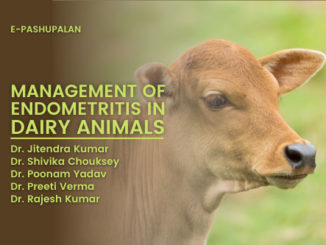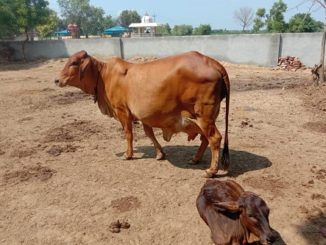It is well known that dystocia cases must be dealt with promptness and due care, because any delay can result in abnormal peurperium or even risk for life of fetus and/or dam. The most important procedure for relieving dystocia is obstetrical mutation, but sometimes it may fail. In those situations, fetotomy offers a second choice, besides caesarean section, to a veterinarian to manage dystocia, that cannot be relieved by obstetrical mutation and/forced extraction although, in most cases, caesarian section is better alternative if fetus is live and viable. But, if examination reveals dead fetus and a safe delivery cannot be made by forced extraction fetotomy is a better alternative.
Fetotomy is defined as the dissection or dismemberment of a fetus in utero, in order to reducing its size and making possible its per-vaginal delivery.
Fetotomy can be either subcutaneous or per-cutaneous. In subcutaneous fetotomy, after incising the fetal skin, and separating underneath musculature and bones (that are dissected at joints) from it, skin is kept intact as point of traction.
In per-cutaneous fetotomy, amputations of fetal parts are done involving the skin. Due to availability of better-designed instruments and ease in performing, only per-cutaneous fetotomy is performed these days.
Indications
It depends on the obstetrician’s experience when to decide for fetotomy in dystocia cases. Excessive force for prolonged duration can cause vaginal, cervical/uterine tears, repture of big vessels, paralysis etc. (Sloss & Dufty, 1980). Fetotomy can also be used in certain contitions like, uncorrectable fetal mal-presentations, feto-pelvic disproportion, and incompletely dilated cervix (but can allow passage of hand and instruments, if encountered (Roberts, 1986)
Prerequisites for fetotomy
Following conditions have to be fulfilled in order to perform a successful fetotomy.
- Fetus should be dead. Live fetus can also be sacrificed in case the dam’s germ-plasm is invaluable.
- Vaginal passage should be well dilated and free of lacerations/tear for safe passage of fetal parts, if otherwise, they can be aggravated with fetotomy instruments and may prove fatal for dam.
- The vaginal passage (Birth canal) should be well lubricated, if not, pump sufficient amount of lubricant into uterus and around fetus. Dried passage is indicative of long standing case.
- Restraining:- If possible animal should be standing through out the procedure. To suppress the continuous straining and sudden movements because of pain epidural anesthesia is given.
- All care must be taken in order to avoid introduction of infection from outside while performing vaginal maneuvers.
- Well designed, properly sterilized instruments should be used.
- The obstetrician should be well acquainted with the technical knowledge and have enough experience to deliver fetus safely by fetotomy.
Lubrication
Lubricant must be used oftenly in sufficient amount for maximum protection. If necessary, a sufficient amount is inserted into the dam’s genital tract and applied around accessible parts of fetus. In those cases where uterus is contracted, sufficient lubrication between fetus and uterine wall relaxes the later and thus provides required working space. Lubrication also provides protection to hands and arms of the obstetrician.
Manipulation in a dry uterus may cause a uterine rupture or tear (sloss & Dufty; 1990). Lubricants that are generally used are white Vaseline mixed with 10% boric acid and parachlorgel (Carboxymethyl cellulose sodium @ 20gm/litre lukewarm water) liquid paraffin, linseed tea are other lubricants that can also be used.
Instruments required
- Boilable metallic case.
- Thygesen’s fetotome (Double barrel.)
- Wire saw and cutter.
- Wire saw handles (D-shaped,/T-shaped)
- Fetotome threader and brush.
- Obstetrical iron chains and wooden bars/handles.
- Krey’s schottler double jointed hook with movable ring.
- Calving rope carrier.
- Sand’s snare introducer or Schriever’s snare introducer.
- Fetotomy knife.
Procedure
After restraining animal in the trevis, cleanse the hindquarters and disinfect with antiseptic solution (savelon, KMnO4 1: 10000 solution etc.). To avoid recumbenay, epidural anesthesia is given. However in recumbent cases, administering epidural anesthesia may cause an animal to stand up due to pain alleviation. (Arthur et al; 1989). 2% solution of Lignocaine HCL, (xylocaine) & Lidocaine @ 4-8 ml injected epidurally produces effect for about 90 minutes (Hall; 1971). Adding isopropyl alcohol to them can prolong the effect for about 8 hours. Bupivacaine HCL 0.5% @ 2-4 ml produces anaesthetic effect for about 170-260 minutes (Mavi, 1990).
As the procedure of fetotomy is stressful (Nakao & grunert, 1989), using tranquilizers which may help the animal to cope up with the situation in a better way chlorpromazine HCL if parenterally administered, produces sedation and relaxes the uterus thus making obstetrical manipulation easy.
Clenbuterol can also be administered parenterally @ 0.3 mg for tocolysis, the effect of which will last for 1-2 hours without any adverse effect.
To perform complete fetotomy of a fetus in anterior or posterior longitudinal presentation, generally six cuts are given in a manner given in Table 1 (as per Bierchwal and de Bois, 1972)
In certain malpresentations, instead of complete, regional/ Partial fetotomy must be performed to deliver the fetus wherein only one or few fetal parts are to be amputated. These mal-postures and the parts to be amputated are given in Table
Table- 1 Guidelines for conducting complete fetotomy of fetus
| Cut | Fetal parts to be amputated | Position of Head of fetotome | Position of loop of wire saw |
| ANTERIOR PRESENTATION | |||
| 1) First | Head (Decapitation) | Behind posterior border of Mandible
/behind ramus of mandible |
Dorsally behind the two ears & all around the neck. |
| 2) Second | Forelimb | Laterally to the limb & placed behind posterior border of scapula (cartilaginous part) | Ventrally between point of elbow & chest |
| 3) Third | Other forelimb | -do- | -do- |
| 4) Fourth | Transverse division of fetal trunk at Anterior portion of chest. | Dorsolaterally and placed behind posterior border of scapula (point of scapular attachment) | All around the trunk and placed behind the scapular attachment (Middle of sternum) |
| 5) Fifth | Transverse division of fetal trunk at posterior portion of chest (at lumbar region) | Dorsolaterally to the trunk till it reaches posterior to last fetal rib. | All round the trunk (At right angle to fetotome head around abdomen) |
| 6) Sixth | Longitudinal division of hind quarters (Pelvis Bi-section) | Caudally to the Coxal Tuber or Anterior to lumbar vertebra (just cranial to Tuber Coxarum of one limb | Between tail and Tuber Ischii (Pin Bone) |
| POSTERIOR PRESENTATION | |||
| 1) First | Hind limb | Laterally Cranial to trochanter major of femur (side of hip joint) | Ventrally medial to the Stifle Joint. (b/w tuber ischium and tail head) |
| 2) Two | Other Hind limb | -do- | -do- |
| 3) Third | Transverse division of fetal trunk (post chest) at lumbar region | Just caudal to last fetal rib (passed dorso-laterally to trunk till it reaches behind first Lumbar vertebrae or posterior to last thoracic vertebrae. | All around the trunk i.e. wire should be placed perpendicular with the head of fetotome in dorsal and ventral position. |
| 4) Fourth | Transverse division of fetal trunk (Antirior chest) (at scapular region) | Guided Dorso-laterally to the trunk and placed infront of posterior border of scapula (posterior to cartilaginous part of scapula)
|
All around the fetal trunk (chest) wire should be perpendicular to the head of fetotome in dorsal & ventral position. |
| 5) Fifth | Diagonal longitudinal division of forepart of fetus (diagonal division of ant. Chest/separation of two forelimbs. | Placed laterally behind the posterior border of Scapula of the opposite limb. (posterior to scapular attachment) | Wire loop passed dorsally over the fetus, guided ventrally below to forelimbs involving base of neck & retrieved on the opposite side of limb, so that the ventral portion of wire faces medial to the Elbow Joint. |
| 6) Sixth | Another technique for separate removal of both forelimbs. | *( A blind incision is made all around the border of scapula for retention of wire as well as head of fetotome)
-Placed behind the scapula in the space created by Blunt Dissection (space b/w scapula & thorax) |
Sand’s share introducer along with loop of wire carried inside, passed b/w the limbs and retrieved ventrally on the same side of limb (Between elbow joint & chest)
* Wire is engaged all around the Border of scapula into the space created by blunt dissection. |
Table-2 Guidelines for fetotomy of fetus with Mal-posture /mal-presentations
| Mal-posture/Presentation | Part (s) to be amputated | |
| 1 | Carpal flexion posture | Amputation of Head.
Or Amputation of one or both the forelimbs below knee. |
| 2 | Shoulder flexion posture | Amputation of Head.
Or Amputation of one or both forelimbs |
| 3 | Lateral deviation of Head | Amputation of one forelimb opposite to the side of head deviation.
Or Amputation of head & Neck. |
| 4 | Hock flexion posture | Amputation of the hind limb (s) below the hock.
Or Amputation of the hind limb. |
| 5 | Hip flexion posture | Amputation of one or both the hind limbs. |
| 6 | Hip-lock condition | Lumbar division & bisection of pelvis |
| 7 | Dog sitting posture | Either the head & forelimbs are to be cut.
Or Lumbar division. |
| 8 | Ventral transverse presentation | Remove whatever part is approachable.
Or Bisect fetus at lumbar region. |
| 9 | Dorsal transverse presentation | Bisect in middle of fetal trunk. |
Detailed analysis of 10 yrs. data on percutaneous fetotomy for management of dystocia revealed minimum postoperative complications with a high dam survival rate in cows and buffaloes in terms of vulvo-vaginal lacerations & oedema. Bierchwal & deBois (1972) have also indicated that no evidence of edema or contusions is a proof of perfect fetotomy operation. Dam survival rate was higher in fetal dystocia as compared to maternal dystocia which might possibly be due to difficult manipulation and extraction of fetal parts thereby stressing the animal, mainly manifested as pain that may ultimately reflect upon their convalescence.Survival and convalescence of cows and buffaloes that undergo fetotomy is better than with caesarian section. Also the number of cuts could be reduced to four if the fetopelvic disproportion is of lesser extent.
In another study on fetal monsters delivered through fetotomy sharma et al. (1992 b) found a high dam survival rate in cattle (100%) and buffaloes (88.6%). Only 2 buffaloes out of 15 died owing to development of emphysema/toxemia. Maternal death rate after fetotomy had been recorded to rise from 3.0-8.4 to 10.1% in emphysematous fetuses. In our conditions, the development of fetal emphysema is very rapid and this often leads to development of postpartum uterine infections, which prolong the service period. It has been recorded that pregnancy rates fall, post fetotomy in cases of fetal emphysema. Roberts (1986) reported 82% post fetotomy conception rate that reduced further and the uterine involution was delayed due to uterine trauma and infections.
Every procedure has its advantages and disadvantages. Likewise, if performed correctly/Judiciously fetotomy is advantageous as:-
- It rapidly reduces the fetus size facilitating its safe delivery per vaginum.
- Excessive stress and inhumane treatment to mother associated with force traction is avoided.
- It bypasses a possible major abdominal surgery (C./S.)
- Dam subsequently needs less after care and recovery is comparatively fast.
- It does not compromise the subsequent fertility of dam.
The drawbacks/Demerits commonly cited for it are:
- It may be more time consuming i.e. complete fetotomy.
- It may be exhaustive for the obstetrician as well as animal.
- It posses risk of injury to obstetrician’s hand and birth canal of dam.
All these disadvantages may be due to lack of properly designed instruments, lack of operators experience and improper technique. Perfection in fetotomy depends on technical knowledge, adequate training and experience, properly designed and sterilized instruments and proper lubrication of birth canal.
| The content of the articles are accurate and true to the best of the author’s knowledge. It is not meant to substitute for diagnosis, prognosis, treatment, prescription, or formal and individualized advice from a veterinary medical professional. Animals exhibiting signs and symptoms of distress should be seen by a veterinarian immediately. |






Be the first to comment